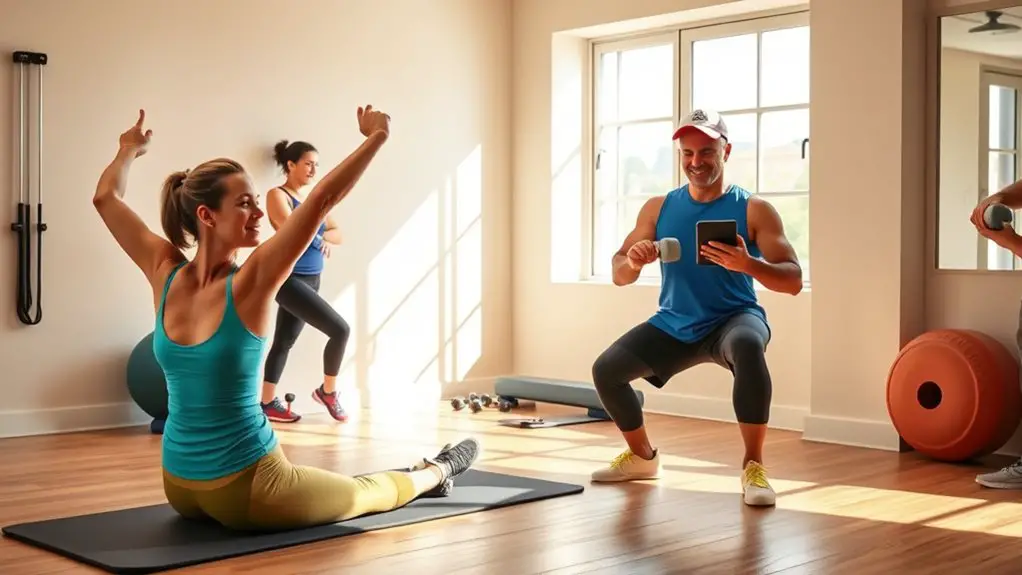How Gym Training Helps in Managing Chronic Pain

Gym training can greatly help manage chronic pain by enhancing muscle strength, flexibility, and endurance. Regular exercise releases endorphins, which naturally relieve pain. Low-impact activities reduce joint stress, while resistance training builds strength around painful areas. In addition, improved flexibility and core stability can alleviate discomfort. Overall, consistent gym attendance fosters a routine that promotes well-being. If you’re interested in finding out more about specific strategies and exercises, there’s more information on how to create an effective training plan.
Understanding Chronic Pain and Its Impact

When you live with chronic pain, it can profoundly affect your daily life and overall well-being. The impact factors of chronic pain are multifaceted, influencing not just your physical health but also your emotional state. Pain perception varies from person to person, meaning that what you experience may not be the same as someone else. This can lead to significant psychological effects, including anxiety and depression, further complicating your situation.
Lifestyle changes often become necessary; simple tasks can become intimidating due to physical limitations. Coping strategies such as mindfulness or relaxation techniques may help, but finding effective pain management solutions is vital. It’s important to understand that while chronic pain can dictate many aspects of life, developing a tailored approach to manage it can lead to improved quality of life. Seeking professional guidance can empower you to navigate these challenges more effectively.
The Role of Gym Training in Pain Management
While chronic pain can feel overwhelming, incorporating gym training into your routine may provide significant relief and enhance your overall well-being. Engaging in structured gym techniques can help you manage pain by improving your strength, flexibility, and endurance. Regular exercise releases endorphins, natural pain relievers that can diminish your discomfort.
Tailoring your gym program to include low-impact activities, such as swimming or cycling, can be particularly beneficial. These methods reduce stress on your joints while promoting blood flow and improving mobility. Additionally, resistance training can strengthen the muscles surrounding painful areas, offering support and stability. Skipping rope is an example of a low-impact activity that can also be beneficial in maintaining fitness levels during times of discomfort.
It’s essential to listen to your body and consult with a healthcare professional before starting any new regimen. With the right approach, gym training can be a powerful tool in your pain management strategy, leading to lasting pain relief and a better quality of life.
Building Strength to Combat Pain

Building strength is essential in managing chronic pain effectively. By enhancing muscle stability and improving joint mobility, you can greatly reduce pain sensitivity over time. This approach not only helps you move more freely but also empowers you to regain control over your daily activities.
Enhancing Muscle Stability
Enhancing muscle stability is essential for managing chronic pain, as stronger muscles support your joints and reduce strain on your body. By focusing on muscle engagement through stability training, you can create a solid foundation that helps alleviate discomfort. Incorporating exercises that target core and stabilizing muscles will improve your overall balance and strength.
| Exercise Type | Benefits |
|---|---|
| Core Stabilization | Enhances trunk stability |
| Balance Training | Improves coordination |
| Resistance Exercises | Builds overall muscle strength |
Through these methods, you’ll not only combat pain but also enhance your daily functional abilities. Remember, consistency is key, and with time, you’ll likely notice significant improvements in your pain management.
Improving Joint Mobility
Improving joint mobility is essential for managing chronic pain, as increased flexibility can greatly reduce discomfort and enhance your range of motion. Engaging in targeted joint exercises and mobility routines can help you regain control over your movements and alleviate pain.
- Start with gentle stretches to warm up your joints.
- Incorporate specific joint exercises that focus on the areas most affected by pain.
- Gradually increase the intensity and duration of your routines to build strength and flexibility.
Reducing Pain Sensitivity
As you focus on managing chronic pain, understanding how strength training can reduce pain sensitivity is essential. Engaging in regular strength exercises helps to build muscle and improve overall resilience, which can enhance your pain thresholds. When your body becomes stronger, it can better handle stressors, leading to a decrease in perceived pain levels. This process, known as sensory modulation, allows your nervous system to adapt, making it less reactive to pain signals. Additionally, strength training promotes the release of endorphins, natural pain-relieving chemicals, which further contribute to reducing discomfort. By incorporating strength training into your routine, you empower yourself to combat chronic pain effectively and improve your quality of life.
Enhancing Flexibility Through Exercise

When you incorporate flexibility training into your exercise routine, you can considerably alleviate the discomfort often associated with chronic pain. Focusing on yoga benefits and effective stretching techniques can enhance your range of motion and reduce stiffness, making daily activities more manageable.
- Increased blood flow: Improved circulation can help in healing and reducing pain.
- Stress relief: Flexibility exercises can promote relaxation, decreasing tension in your muscles.
- Joint health: Regular stretching keeps joints limber, preventing further injury and discomfort.
Engaging in activities like yoga not only provides physical benefits but also encourages mindfulness, helping you cope with pain more effectively. By dedicating time to flexibility training, you’re investing in your overall well-being, gaining the ability to move freely and confidently, which is essential for managing chronic pain. Additionally, incorporating dynamic stretching techniques can further enhance your flexibility and prepare your body for exercise.
Improving Endurance for Better Daily Functioning
Building on the benefits of flexibility training, enhancing your endurance can greatly impact your daily functioning and overall quality of life. Improving your stamina through cardio workouts allows you to perform everyday tasks with less fatigue and discomfort. Activities like walking, cycling, or swimming not only boost your cardiovascular health but also help your body manage pain more effectively. As you engage in regular stamina building, you’ll notice increased energy levels, making it easier to participate in social activities or even tackle household chores. This newfound endurance can also lead to better sleep quality, which is vital for pain management. Moreover, consistent cardio workouts stimulate the release of endorphins, your body’s natural painkillers, further alleviating chronic pain symptoms. Incorporating jump rope workouts into your routine can be an effective way to build stamina and improve overall fitness. By prioritizing endurance training, you’re taking a proactive step toward enhancing your overall well-being and reclaiming control over your daily life.
Creating a Personalized Gym Training Plan

Creating a personalized gym training plan is essential for effectively managing chronic pain while ensuring you stay motivated and engaged in your fitness journey. Start by focusing on goal setting; identify specific, achievable targets that align with your needs and limitations.
Consider incorporating these elements into your plan:
- Exercise variation: Mix different types of workouts, such as strength training, flexibility exercises, and low-impact cardio, to prevent boredom and promote overall muscle balance. Adding alternatives like jumping jacks can enhance your cardiovascular fitness without the need for equipment.
- Regular assessments: Periodically evaluate your progress and adjust your goals accordingly. This keeps you on track and helps you recognize improvements.
- Listen to your body: Pay attention to how different exercises affect your pain levels, and modify your plan based on your body’s responses.
Frequently Asked Questions
Can Gym Training Worsen Chronic Pain Symptoms in Some Individuals?
Yes, gym training can worsen chronic pain symptoms in some individuals. It’s vital to understand that pain exacerbation can occur if the intensity or type of exercise isn’t tailored to your specific needs. Individualized approaches that consider your unique condition, limitations, and goals are important. Consulting with a healthcare professional can help guarantee that your training regimen supports rather than hinders your well-being, allowing you to manage your pain more effectively.
How Often Should I Train to Manage Chronic Pain Effectively?
To manage chronic pain effectively, it’s important to follow frequency guidelines that suit your individual needs. Aim for training sessions three to five times a week, incorporating both low-impact exercises and strength training. Listen to your body; if you experience increased discomfort, adjust the frequency or intensity accordingly. Consistency is key in pain management, so find a routine that works for you while ensuring you allow time for recovery.
What Types of Exercises Should I Avoid With Chronic Pain?
Steering through chronic pain can feel like walking on a tightrope, where balance is essential. You’ll want to avoid high impact exercises like running or jumping, as they can exacerbate your pain. Instead, focus on gentle strength training that builds stability without strain. Exercises like resistance bands or bodyweight movements can be beneficial. Always listen to your body, and consult a professional to tailor an approach that suits your unique needs.
Are There Specific Gym Machines Recommended for Chronic Pain Sufferers?
When considering gym machines for chronic pain, low impact machines like stationary bikes and elliptical trainers are often recommended. These options minimize stress on your joints while providing cardiovascular benefits. Resistance training machines, such as leg presses and seated rows, can help strengthen muscles without excessive strain. It’s essential to start slowly and listen to your body, ensuring you’re not exacerbating any pain. Consulting a healthcare professional for personalized advice is always a wise choice.
Is Professional Guidance Necessary for Gym Training With Chronic Pain?
Imagine traversing a labyrinth, where each turn holds the potential for relief or discomfort. When you’re dealing with chronic pain, having a guide—like a professional trainer—can be invaluable. They craft personalized plans tailored to your needs and abilities, ensuring you’re on the right path. Expert recommendations can help you avoid pitfalls and optimize your training, allowing you to progress safely. With guidance, you’re more likely to find your way to comfort and strength.





